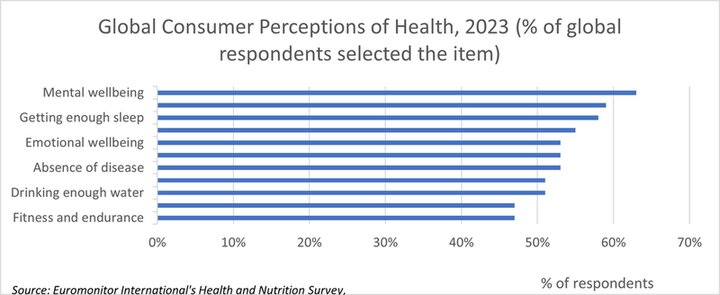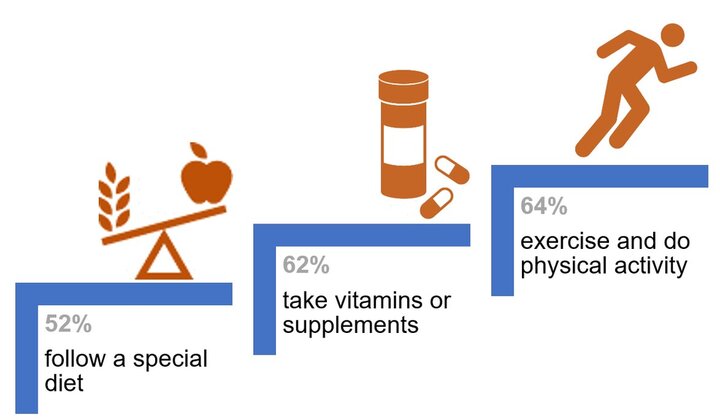KEYWORDS
Wellness
Healthy ageing
Consumer behaviour
Longevity
Brain
Skin
Metabolic
Joint
Immunity
Abstract
Wellness has been identified by Euromonitor International as having the furthest-reaching impact on industries and consumers in the future. Consumers’ future health concerns tend to focus on age-related health problems, while lifestyle-related diseases still play an important role. In the meantime, perceptions towards health will continue to evolve, on the back of rising living standards, urbanisation and changing social structure. This report looks at the link between rising longevity and consumers’ search for a healthy ageing and highlights the potential impact of the behaviour of healthier consumers on consumer goods industries in the years to come.
Global health challenges are shifting towards lifestyle-related diseases and mental health issues
Life expectancy has increased worldwide. Longevity has been accompanied by a greater number of healthy years of life. The desire to be healthier is also shifting from fighting the signs of aging to focusing on prevention and looking and feeling good at any age.
Consumers' desire to stay healthy as they age is driving demand for health and wellness products ranging from food and nutrition to activities. This demand is not limited to the elderly, however, as middle-aged and even younger consumers are increasingly expressing an interest in holistic, healthy living throughout the natural aging process.
Health habits and attitudes are an important aspect of consumers' lives, often influencing their day-to-day and long-term decisions, from dietary restrictions to purchasing behavior. Euromonitor International's Health and Nutrition Survey reveals different perceptions of health across age groups, but for all respondents, a balanced diet (nutrition), physical strength and emotional wellbeing are common elements in the definition of being healthy.
Circulatory diseases, which include heart disease and stroke, remain the leading cause of death worldwide. People in developed countries are more susceptible to CVD, but the problem is growing in developing countries due to rising obesity rates and sedentary lifestyles.
Meanwhile, better education, increased access to healthcare and rising incomes, particularly in developing countries, have helped to significantly reduce death rates from respiratory and infectious diseases such as tuberculosis, bronchitis and influenza.
Lifestyle factors such as consumption of foods high in cholesterol, stress, hypertension, diabetes, obesity, lack of exercise and excessive alcohol consumption remain central to human health, as they can all contribute to the development of cardiovascular and mental diseases.
Mental and behavioral disorders are the group of diseases with the highest increase in deaths in developed countries, highlighting the growing problem of depression and other mental illnesses in these markets.
Economic recession, unemployment, aging, social isolation and changing family structures are among the factors that could contribute to the rise in mental illness in developed countries. According to Euromonitor's Health and Nutrition Survey 2023 (HNS), 58.72% of respondents in Italy reported facing extreme to moderate levels of stress on a daily basis.
Staying healthy is among consumers’ top priorities
Diet and physical activity are at the center of consumers' preventive health measures.
Physical activity is the most popular approach. It is seen as helping people not only to lose weight and stay fit, but also to improve mental health.
A significant group of consumers are also looking for convenient ways to get enough nutrients and vitamins through dietary supplements.
Diet is also becoming an important preventive health measure, with consumers generally seeking to reduce consumption of alcohol, fat, sugar and salt and increase consumption of plant-based foods.
While the desire to stay healthy and fit is strong, people may not have enough time to follow the diet and exercise regimens they desire. Taking vitamins and dietary supplements has therefore become a popular health prevention approach among consumers due to its convenience.
The prevalence of health prevention approaches, combined with rising income and education levels, will continue to support the consumption of vitamins and dietary supplements in all regions in the coming years. However, brands that look beyond convenience and focus on consumers' long-term health behaviors stand to benefit the most from this attractive market.
Gut-brain-axis
A great example of a grape extract for our conversation is Cognigrape. Cognigrape is high in the polyphenols anthocyanins and proanthocyanidins and can improve cognitive performance in elderly people by acting on attention and immediate and delayed memory. (17)
Gut-joint-axis
Turmeric/Curcumin (HydroCurc®) is a perfect example for the joint health category; not only is HydroCurc® (turmeric/curcumin) high in polyphenols, but it has multiple clinical studies showing its benefits for joint health and discomfort. (18)

Chart 1. Global Consumer Perceptions of Health. 2023 (% of global respondents selected the item)

Graphic 1. Most Popular Approaches to Health Prevention 2023
(% of global respondents selected the approach)
Wellness as an answer to Longevity and the Quest for Healthy Ageing
Nutritional habits
Consumers are rethinking their eating habits, with many looking to increase their intake of healthy nutrients that can help them live more years in good health. Cross-industry product offerings and innovations in packaging, format, formulation and functionality can be considered by manufacturers as a means to address the different priorities of different age groups. Innovation around traditional ingredients, flavours and healing concepts could also be lucrative across cohorts.
Physical wellness
The importance of physical wellness as a means to healthy aging continues to grow globally. Consumers are taking a holistic view of health - both feeling and looking healthy. Increased participation in physical activity, driven by both government initiatives and self-care awareness, is expected to benefit categories such as sports nutrition, health and wellness foods and beverages, and sports apparel to support better exercise performance. Healthy skin is a priority as consumers move away from targeted anti-aging. Natural and organic ingredients and simplified beauty steps create opportunities to meet the demand for clear and healthy-looking skin.
Internal balance
Recognition of the importance of inner balance, measured by factors such as mental health, memory, sleep and stress, is growing globally. Consumers of all ages are looking to address issues such as stress and sleep. Manufacturers should be aware of the cultural nuances and fluidity of demand across age groups globally to identify and target consumers with curated products and marketing strategies. Nibbles and RTD (ready-to-drink) beverages with plant-based ingredients and targeted functionality, as well as digitization of services, are key opportunities in this space.
Gut-metabolic-axis
We will stay in the Mediterranean again with the ingredient Morosil (red moro orange). Red Moro oranges are high in anthocyanins (polyphenols), and research completed with Morosil shows it impacts body weight, waist circumference, and hip circumference. (21)
Gut-skin-axis
We will see amla listed if we refer to the list of ingredients with specific effects on gut health. Amla is also high in polyphenols, and research shows it is an excellent skin health, primarily in control of collagen metabolism. (22)
Conclusion
Looking ahead, the aging population will have a huge impact on the future healthcare landscape.
With nearly 12.0% of the world's population aged 65 and over by 2030, age-related health issues such as memory loss, incontinence, mobility problems and eye/vision problems will continue to rise and become a major concern for consumers.
Lifestyle-related diseases and mental health issues will continue to be major health concerns, particularly in developing countries where rapid urbanization and changing work/life conditions are having a major impact on people's diets, physical activity and social relationships.
Driven by technology and innovation, consumers around the world are becoming increasingly informed about health issues and their health status. Understanding their health behaviors and anticipating their future needs is critical for companies today.
With the rise of stress and anxiety, mental and emotional health will continue to grow in importance as consumers seek happiness as the ultimate form of health status.
The commercialization of "happiness" may be a future prospect, as a large proportion of global consumers already associate health with mental wellbeing.
References and notes
- (Euromonitor: Global Market Research & Industry Analysis - Euromonitor.com)
- Euromonitor International‘s Health and Nutrition Survey, 2023
- Euromonitor International’s Passport Internal Database



